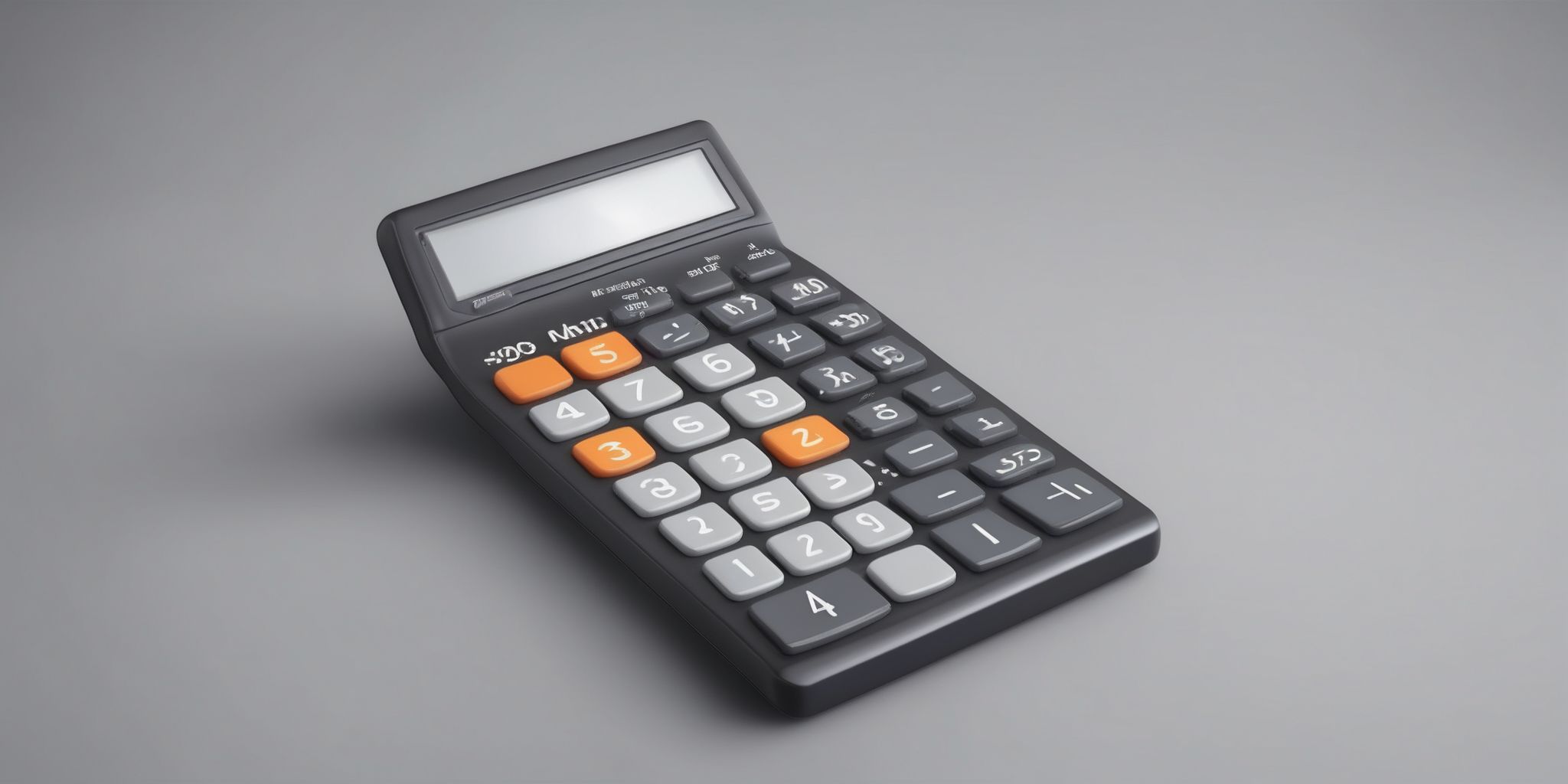Using a Personal Finance Calculator: Simplifying Financial Planning
Do you ever catch yourself looking at your bank account and feeling like your money is disappearing into a black hole? Or find yourself baffled by terms like interest rates, APR, or compound interest? Trust me, you're not alone. Navigating personal finance can be overwhelming, but luckily, there's a helpful tool at your fingertips - the personal finance calculator.
With just a few clicks, this nifty little tool can simplify your financial planning, giving you clarity, control, and confidence inmanaging your money. So, buckle up and get ready to dive into the world of personal finance calculators, as we uncover the secrets to smart financial decision-making.
What is a Personal Finance Calculator?
A personal finance calculator is a powerful tool that helps individuals manage their finances efficiently. It provides a range of features to assist in budgeting, savings, investing, and debt management. With a personal finance calculator, you can accurately assess your financial situation, track expenses, and create realistic budgets. It enables you to set goals, estimate savings growth, and analyze investment options.
Additionally, you can calculate loan repayment plans, compare interest rates, and explore debt consolidation strategies. By utilizing a personal finance calculator, you gain greater control over your financial decisions and can make informed choices for a more secure financial future.
Why is Financial Planning Important?
Financial planning is the foundation for achieving our monetary goals. It helps us prioritize our spending, save for the future, and make informed financial decisions. By setting clear objectives and mapping out a plan, we can better control our money and avoid unnecessary debt or financial stress. A personal finance calculator simplifies the process by providing accurate calculations and projections, allowing us to see the impact of our financial choices.
Whether it's creating a budget, tracking expenses, or planning investments, a personal finance calculator ensures we stay on track and make informed decisions that align with our financial goals.
Benefits of Using a Personal Finance Calculator
Accurate Financial Assessment
An accurate financial assessment is a fundamental aspect of personal finance planning, and a personal finance calculator can greatly simplify this process. Here's why it matters:
- It provides a clear overview of your income, expenses, assets, and liabilities, allowing you to understand where your money is coming from and where it's going.
- By inputting accurate and detailed information, you can gain insights into your financial health and identify areas where you may be overspending or neglecting savings.
- It helps you evaluate your net worth and track changes over time, enabling you to set realistic financial goals and make informed decisions about investments and debt management.
- With precise calculations, you can identify patterns or trends, make adjustments to your budget, and improve your overall financial well-being.
In short, using a personal finance calculator ensures you have a solid foundation for effective financial planning and empowers you to make better money-related decisions.
Efficient Budgeting and Expense Tracking
Efficient budgeting and expense tracking are fundamental aspects of effective financial management. A personal finance calculator simplifies this process by providing a centralized platform to input and categorize income and expenses. It allows users to track their spending patterns, identify areas of overspending, and make necessary adjustments to meet their financial goals.
For instance, users can set spending limits for different categories such as groceries, entertainment, or transportation, and monitor their progress regularly. This helps individuals gain a clearer understanding of their financial habits and make informed decisions to optimize their budget. With accurate expense tracking, they can easily identify areas where they can save money and allocate those savings towards their savings goals or debt repayment.
Savings and Investment Planning
A personal finance calculator is a valuable tool for effective savings and investment planning. It helps individuals assess their financial goals and determine how much they need to save regularly to achieve them. By inputting information such as expected returns and timeframes, the calculator can provide projections on the growth of investments over time. This empowers users to make informed decisions about where to allocate their funds and stay on track with their savings targets.
For example, it can illustrate the potential impact of increasing monthly contributions or adjusting investment strategies. With a personal finance calculator, individuals can take charge of their long-term financial well-being.
Debt Management and Loan Repayment
One of the practical applications of a personal finance calculator is in managing debt and planning loan repayment. By inputting your outstanding debts, interest rates, and repayment terms, you can easily determine the optimal repayment strategy. The calculator can help you evaluate different scenarios, such as paying off high-interest debts first or focusing on reducing overall debt.
Additionally, it allows you to estimate the total interest paid over time, helping you make informed decisions in accelerating your repayment process. With a personal finance calculator, you can take control of your debt and work towards becoming debt-free more efficiently.
How to Choose the Right Personal Finance Calculator
Consider Your Financial Goals
Consider your financial goals when choosing a personal finance calculator. Knowing what you want to achieve financially will help you find a tool that aligns with your objectives.
For example, if your goal is to save for a down payment on a house, you’ll need a calculator that emphasizes savings and investment planning. If you want to pay off debt quickly, look for a calculator that focuses on debt management strategies. By considering your financial goals, you can select a personal finance calculator that provides the necessary features and functionality to support your specific needs.
Evaluate Available Features
When considering a personal finance calculator, it's important to assess the available features to ensure it meets your specific needs. Here are some points to consider:
- Customization: Look for a calculator that allows you to customize variables such as income, expenses, and savings goals for a personalized financial plan.
- Multiple Calculations: A calculator that can handle various calculations, such as budgeting, savings, investments, and debt repayment, offers greater versatility.
- Interactive Graphs: Visual representations of your financial data can aid in understanding and decision-making. Look for calculators that provide interactive graphs and charts.
- Real-Time Updates: Up-to-date information is crucial for accurate financial planning. Seek a calculator that offers real-time updates and reflects changes to your inputs instantly.
- Mobile Compatibility: A calculator that is accessible on mobile devices allows you to manage your finances on-the-go.
By considering these features, you can find a personal finance calculator that aligns with your requirements and assists you in simplifying your financial planning process.
User-Friendly Interface and Accessibility
- A personal finance calculator should have a user-friendly interface, making it easy for individuals to navigate and input their financial information.
- Clear instructions, intuitive design, and straightforward input fields can enhance the user experience and make the calculator accessible to individuals with varying levels of financial expertise.
- Features like drop-down menus, sliders, and tooltips can provide users with additional guidance and simplify the process of entering data accurately.
- Accessibility is also crucial, ensuring that the calculator is compatible with different devices and screen sizes, allowing users to access it conveniently from their smartphones, tablets, or computers.
- An example of a user-friendly interface is a calculator that visually breaks down expenses into categories and subcategories, allowing users to easily allocate their budget and track their spending.
Read User Reviews and Recommendations
When choosing a personal finance calculator, it is important to read user reviews and recommendations. These insights provide valuable information about the calculator's usability, accuracy, and overall effectiveness. Users often share their experiences, highlighting the features they liked or disliked, and offering suggestions for improvement. By considering these reviews, you can gain a deeper understanding of how the calculator performs in real-world situations.
Look for reviews that mentionspecific scenarios or examples, as they can offer practical insights into how the calculator can be applied to your own financial planning.
Using a Personal Finance Calculator for Budgeting
Calculating Income and Expenses
Calculating Income and Expenses with a Personal Finance Calculator:
1.Determine Your Total Income:
- Input your monthly salary, bonuses, freelance income, and any other sources of revenue.
- Include all income sources to accurately gauge your financial situation.
2.Identify Fixed Expenses:
- Enter recurring bills such as rent/mortgage, utilities, insurance premiums, and loan repayments.
- Knowing fixed expenses helps establish a baseline for budgeting effectively.
3.Track Variable Expenses:
- Categorize discretionary spending like dining out, entertainment, and shopping.
- Include occasional expenses such as vacations or home maintenance.
4.Analyze the Numbers:
- Review the calculations to understand your income-to-expenses ratio.
- Identify areas where you may need to adjust spending or increase income.
5.Fine-tune Your Budget:
- Make necessary adjustments to allocate funds for savings, debt repayment, or investment goals.
- A personal finance calculator simplifies the process, making budgeting more efficient.
Creating Realistic Spending Categories
When utilizing a personal finance calculator, it's important to create realistic spending categories to gain a clear understanding of your expenses. Here's how to approach this process:
- Analyze your previous expenses: Review your bank statements and receipts to identify recurring expenses and irregular spending patterns.
- Categorize expenses: Group similar expenses together, such as housing, transportation, groceries, entertainment, and debt repayments.
- Prioritize essential expenses: Allocate a portion of your budget for necessary expenses like rent, utilities, and groceries.
- Consider discretionary spending: Evaluate non-essential expenses like dining out or entertainment and allocate an appropriate amount for these categories.
- Be flexible: Adjust your spending categories as needed based on changes in your financial situation or goals.
By creating realistic spending categories, you can better manage your finances and make informed decisions about how to allocate your income.
Tracking and Analyzing Expenses
Tracking and analyzing expenses is a fundamental aspect of effective financial management. Personal finance calculators simplify this process by providing a centralized platform to record and categorize your expenditures. By regularly inputting your expenses, you can gain valuable insights into your spending patterns and identify areas where you can cut back or reallocate funds.
For example, you may discover that you're spending a significant portion of your income on eating out, prompting you to start cooking more at home to save money. Through the use of a personal finance calculator, you can actively monitor your expenses and make informed decisions to improve your financial well-being.
Adjusting the Budget and Savings
- Regularly reviewing and adjusting your budget is vital for maintaining financial stability and reaching your goals. A personal finance calculator can help simplify this process.
- Analyze your spending patterns and identify areas where you can cut back to save more. For example, reducing unnecessary subscriptions or dining out less frequently.
- Allocate a percentage of your income towards savings and investments. Use the calculator to determine how much you can comfortably save each month.
- If your expenses increase or you face unexpected financial obligations, adjust your budget accordingly. A financial calculator enables you to see the impact of these changes on your overall financial plan.
- Remember to be realistic and flexible when adjusting your budget. It's important to strike a balance between your financial goals and day-to-day expenses.
Utilizing a Personal Finance Calculator for Savings and Investments
Setting Financial Goals
Setting financial goals is a fundamental step in effectively managing personal finances. It helps create a roadmap for your financial journey and provides clarity about what you want to achieve. When using a personal finance calculator, you can set specific and measurable goals, such as saving for a down payment on a house or building an emergency fund.
By inputting your current income, expenses, and desired time frame, the calculator can help you determine how much you need to save each month to reach your goals. This actionable approach keeps you motivated and accountable on your path to financial success.
Estimating Returns and Compounding Interest
- Use a personal finance calculator to determine potential returns on investments.
- Enter the initial investment amount, expected interest rate, and time period to calculate the future value.
- Consider the power of compounding interest, which allows your money to grow exponentially over time.
- For example, investing $1,000 at a 5% annual interest rate for 10 years would result in a future value of $1,628.89.
- Adjust variables like interest rate and time to explore different investment scenarios.
- This feature helps in making informed decisions about investment opportunities and setting realistic financial goals.
Determining Investment Options
When using a personal finance calculator, determining investment options becomes effortless. By inputting factors such as risk tolerance, investment goals, and time horizon, the calculator provides insights into suitable investment options.
For example, based on a long-term goal with moderate risk tolerance, it might suggest a diversified portfolio consisting of stocks, bonds, and mutual funds. The calculator can also generate hypothetical scenarios by adjusting variables such as investment amount or time horizon, allowing users to compare potential returns and make well-informed decisions. With this actionable information, individuals can confidently select investment options aligned with their financial objectives.
Monitoring and Readjusting Investments
- Regularly monitor the performance of your investments with the help of a personal finance calculator.
- Analyze the returns and make adjustments to ensure they align with your financial goals.
- Keep an eye on market trends and economic indicators that may impact your investments.
- Stay informed about changes in interest rates, inflation rates, and other relevant factors.
- Consider diversifying your investment portfolio to mitigate risk and optimize returns.
- Keep an open mind and be willing to make changes when necessary to maximize your investment potential.
- Seek advice from financial experts or utilize investment tools to gain insights and make informed decisions.
- Remember that monitoring and readjusting investments is an ongoing process to adapt to changing market conditions.
Managing Debt with a Personal Finance Calculator
Calculating Loan Repayment Plans
- A personal finance calculator simplifies the process of determining loan repayment plans.
- Input the loan amount, interest rate, and term into the calculator to get accurate results.
- The calculator generates a repayment schedule, showing monthly payments and total interest paid over the loan term.
- Experiment with different scenarios by adjusting variables like interest rates or repayment periods to find the most suitable plan.
- Use the calculator to compare different loans from various lenders to make an informed decision.
- Take advantage of the calculator's visualization features to understand the impact of early payments or additional principal payments on the overall loan term.
- By using a personal finance calculator for calculating loan repayment plans, individuals can make informed financial decisions and strategically manage their debt.
Comparing Interest Rates and Terms
Comparing interest rates and terms is a vital step when using a personal finance calculator. By analyzing different loan offers, you can determine the most cost-effective option for your financial situation. Consider the interest rate, which directly affects the total amount you'll repay.
Additionally, evaluate the loan term, as longer terms may result in lower monthly payments but higher overall interest payments.
For example, comparing a 3-year versus a 5-year car loan can show the impact on total interest paid. By conducting this comparison, you can make informed decisions and save money in the long run.
Exploring Debt Consolidation Options
When dealing with multiple debts, exploring debt consolidation options can help simplify your financial situation. Debt consolidation involves combining your debts into a single loan, often with a lower interest rate. By doing so, you can streamline your monthly payments and potentially save on interest costs. A personal finance calculator can assist in comparing the savings and determining the ideal consolidation strategy. Whether it's through a balance transfer credit card, personal loan, or home equity loan, taking the time to research and compare different options can help you make informed decisions and accelerate your path to becoming debt-free.
Accelerating Debt Payoff Strategies
- Utilize a personal finance calculator to determine the most effective strategies for paying off debt faster.
- Allocate extra funds towards debt repayment by cutting unnecessary expenses or increasing income.
- Consider the debt avalanche method, focusing on paying off high-interest debts first to minimize long-term interest payments.
- Alternatively, try the debt snowball approach, paying off smaller debts first to gain momentum and motivation.
- Explore balance transfer options or negotiate lower interest rates with creditors to reduce overall debt burden.
- Consolidate multiple debts into a single loan with a lower interest rate, simplifying repayment and potentially saving money.
- Regularly review and adjust your debt payoff plan to stay on track and make consistent progress towards becoming debt-free.
Conclusion
Calculating personal finances can be overwhelming and time-consuming, but using a personal finance calculator can simplify the process. These tools help individuals plan their finances by inputting their income, expenses, and goals, and receiving instant calculations and projections. A personal finance calculator eliminates the need for manual calculations and provides a clear overview of one's financial situation. It enables users to budget effectively, track expenses, and set financial goals.
By using a personal finance calculator, individuals can gain better control over their money and make informed decisions for a secure financial future.


